The Tourism Industry and Marine Ecosystem of Australia
VerifiedAdded on 2022/12/27
|18
|4579
|1
AI Summary
This report identifies the problems posed in the tourism industry in Australia by the degradation of the Great Barrier Reef and discusses the policies of the government to protect this ecosystem.
Contribute Materials
Your contribution can guide someone’s learning journey. Share your
documents today.
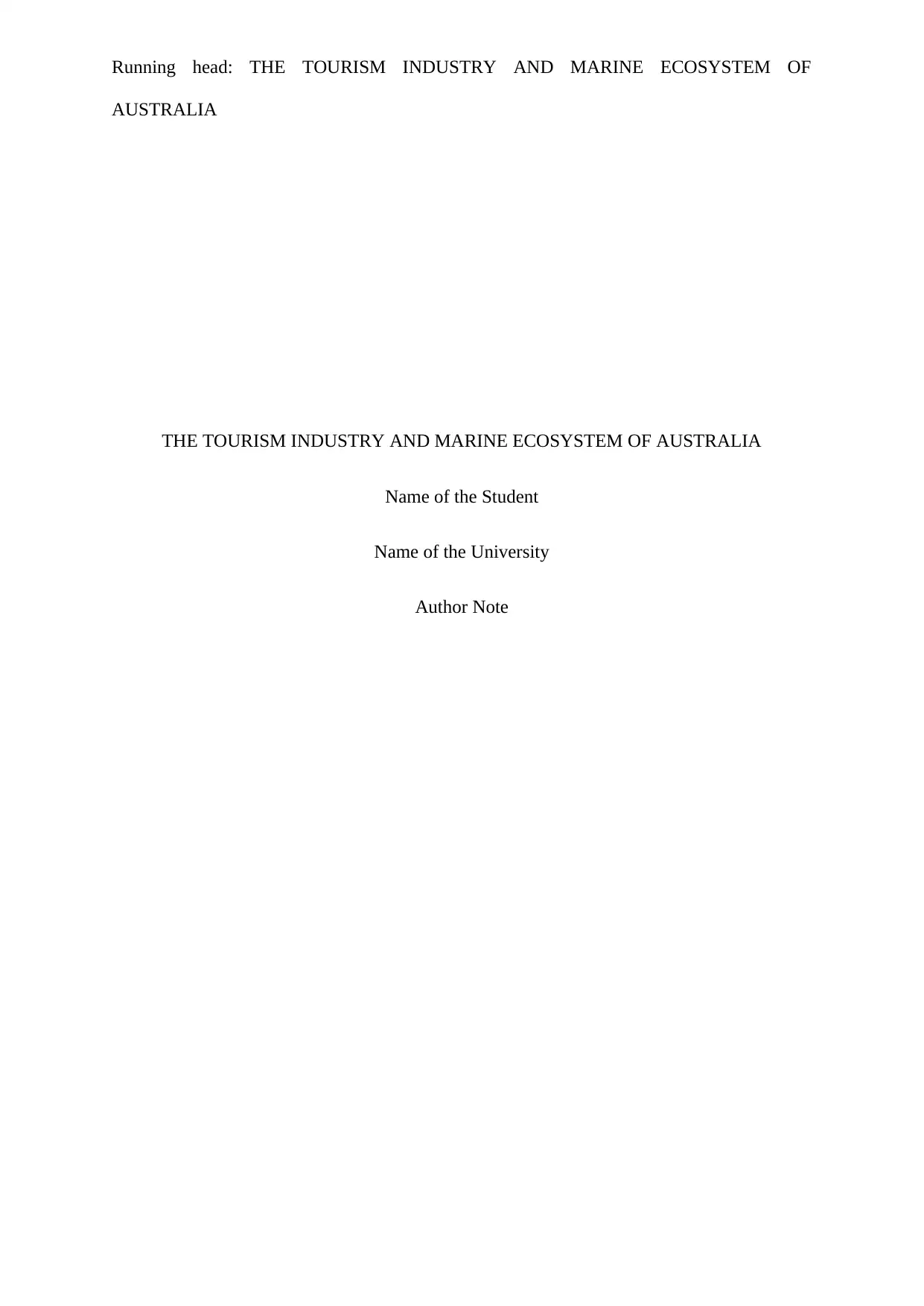
Running head: THE TOURISM INDUSTRY AND MARINE ECOSYSTEM OF
AUSTRALIA
THE TOURISM INDUSTRY AND MARINE ECOSYSTEM OF AUSTRALIA
Name of the Student
Name of the University
Author Note
AUSTRALIA
THE TOURISM INDUSTRY AND MARINE ECOSYSTEM OF AUSTRALIA
Name of the Student
Name of the University
Author Note
Secure Best Marks with AI Grader
Need help grading? Try our AI Grader for instant feedback on your assignments.
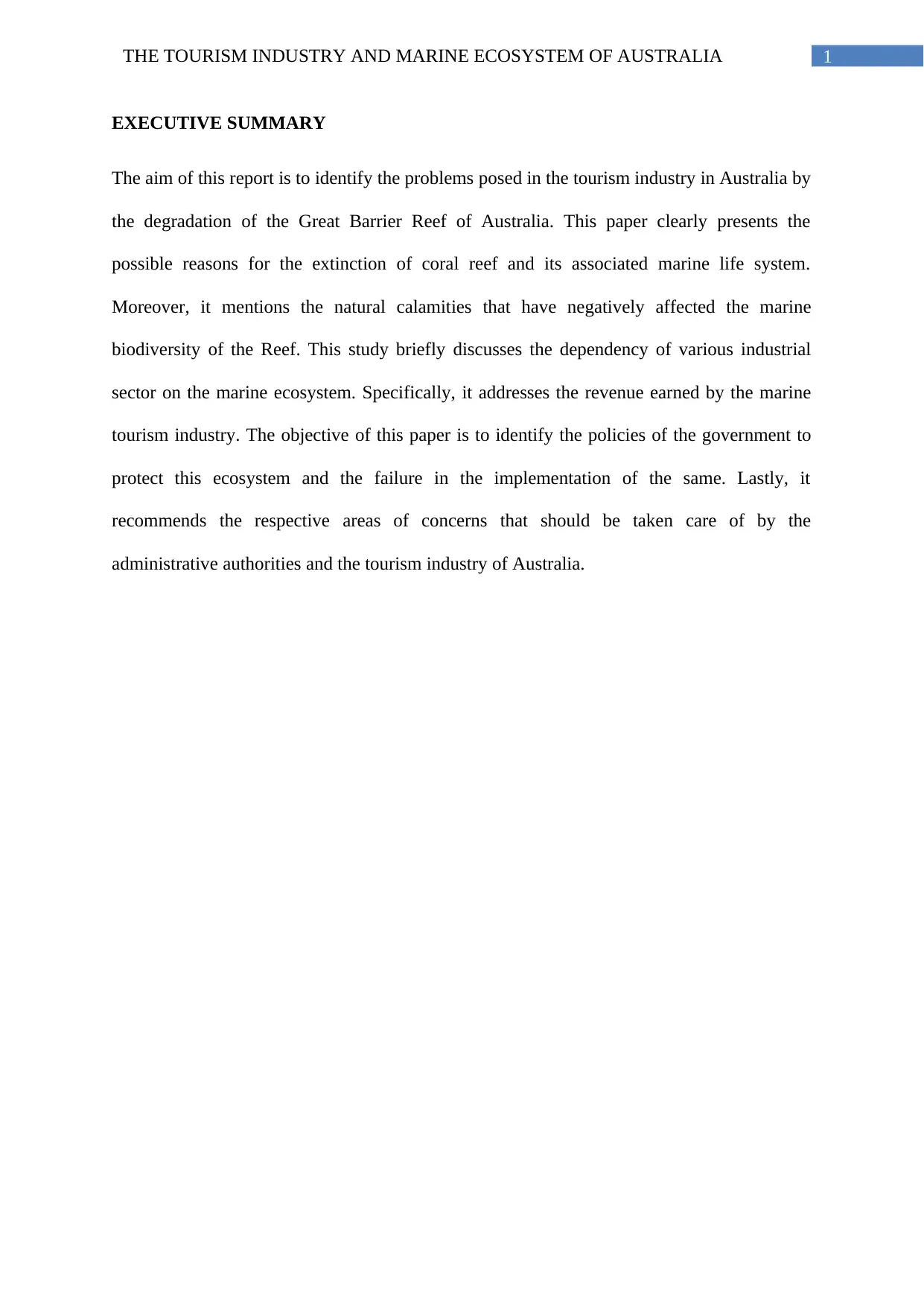
1THE TOURISM INDUSTRY AND MARINE ECOSYSTEM OF AUSTRALIA
EXECUTIVE SUMMARY
The aim of this report is to identify the problems posed in the tourism industry in Australia by
the degradation of the Great Barrier Reef of Australia. This paper clearly presents the
possible reasons for the extinction of coral reef and its associated marine life system.
Moreover, it mentions the natural calamities that have negatively affected the marine
biodiversity of the Reef. This study briefly discusses the dependency of various industrial
sector on the marine ecosystem. Specifically, it addresses the revenue earned by the marine
tourism industry. The objective of this paper is to identify the policies of the government to
protect this ecosystem and the failure in the implementation of the same. Lastly, it
recommends the respective areas of concerns that should be taken care of by the
administrative authorities and the tourism industry of Australia.
EXECUTIVE SUMMARY
The aim of this report is to identify the problems posed in the tourism industry in Australia by
the degradation of the Great Barrier Reef of Australia. This paper clearly presents the
possible reasons for the extinction of coral reef and its associated marine life system.
Moreover, it mentions the natural calamities that have negatively affected the marine
biodiversity of the Reef. This study briefly discusses the dependency of various industrial
sector on the marine ecosystem. Specifically, it addresses the revenue earned by the marine
tourism industry. The objective of this paper is to identify the policies of the government to
protect this ecosystem and the failure in the implementation of the same. Lastly, it
recommends the respective areas of concerns that should be taken care of by the
administrative authorities and the tourism industry of Australia.
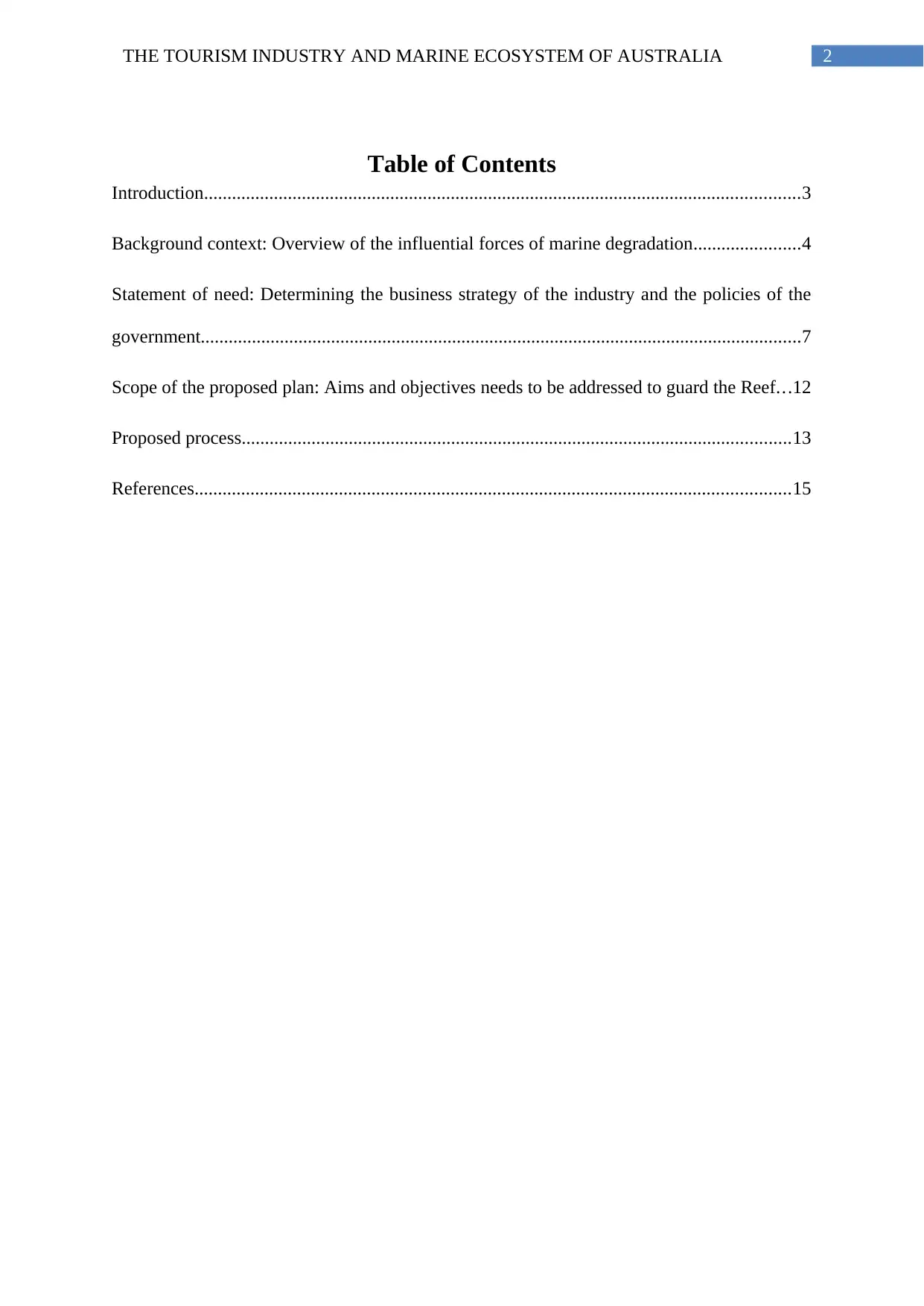
2THE TOURISM INDUSTRY AND MARINE ECOSYSTEM OF AUSTRALIA
Table of Contents
Introduction................................................................................................................................3
Background context: Overview of the influential forces of marine degradation.......................4
Statement of need: Determining the business strategy of the industry and the policies of the
government.................................................................................................................................7
Scope of the proposed plan: Aims and objectives needs to be addressed to guard the Reef...12
Proposed process......................................................................................................................13
References................................................................................................................................15
Table of Contents
Introduction................................................................................................................................3
Background context: Overview of the influential forces of marine degradation.......................4
Statement of need: Determining the business strategy of the industry and the policies of the
government.................................................................................................................................7
Scope of the proposed plan: Aims and objectives needs to be addressed to guard the Reef...12
Proposed process......................................................................................................................13
References................................................................................................................................15
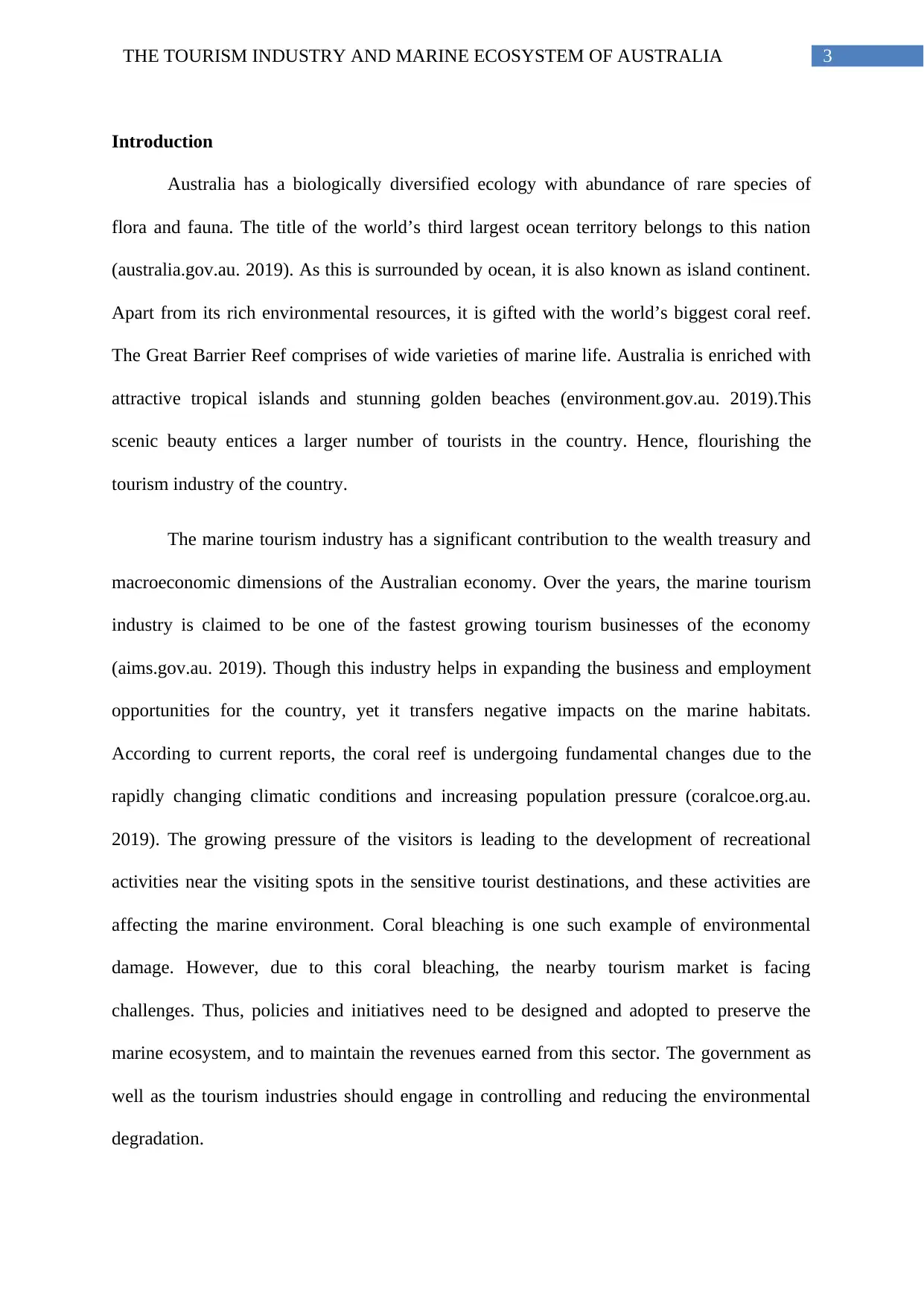
3THE TOURISM INDUSTRY AND MARINE ECOSYSTEM OF AUSTRALIA
Introduction
Australia has a biologically diversified ecology with abundance of rare species of
flora and fauna. The title of the world’s third largest ocean territory belongs to this nation
(australia.gov.au. 2019). As this is surrounded by ocean, it is also known as island continent.
Apart from its rich environmental resources, it is gifted with the world’s biggest coral reef.
The Great Barrier Reef comprises of wide varieties of marine life. Australia is enriched with
attractive tropical islands and stunning golden beaches (environment.gov.au. 2019).This
scenic beauty entices a larger number of tourists in the country. Hence, flourishing the
tourism industry of the country.
The marine tourism industry has a significant contribution to the wealth treasury and
macroeconomic dimensions of the Australian economy. Over the years, the marine tourism
industry is claimed to be one of the fastest growing tourism businesses of the economy
(aims.gov.au. 2019). Though this industry helps in expanding the business and employment
opportunities for the country, yet it transfers negative impacts on the marine habitats.
According to current reports, the coral reef is undergoing fundamental changes due to the
rapidly changing climatic conditions and increasing population pressure (coralcoe.org.au.
2019). The growing pressure of the visitors is leading to the development of recreational
activities near the visiting spots in the sensitive tourist destinations, and these activities are
affecting the marine environment. Coral bleaching is one such example of environmental
damage. However, due to this coral bleaching, the nearby tourism market is facing
challenges. Thus, policies and initiatives need to be designed and adopted to preserve the
marine ecosystem, and to maintain the revenues earned from this sector. The government as
well as the tourism industries should engage in controlling and reducing the environmental
degradation.
Introduction
Australia has a biologically diversified ecology with abundance of rare species of
flora and fauna. The title of the world’s third largest ocean territory belongs to this nation
(australia.gov.au. 2019). As this is surrounded by ocean, it is also known as island continent.
Apart from its rich environmental resources, it is gifted with the world’s biggest coral reef.
The Great Barrier Reef comprises of wide varieties of marine life. Australia is enriched with
attractive tropical islands and stunning golden beaches (environment.gov.au. 2019).This
scenic beauty entices a larger number of tourists in the country. Hence, flourishing the
tourism industry of the country.
The marine tourism industry has a significant contribution to the wealth treasury and
macroeconomic dimensions of the Australian economy. Over the years, the marine tourism
industry is claimed to be one of the fastest growing tourism businesses of the economy
(aims.gov.au. 2019). Though this industry helps in expanding the business and employment
opportunities for the country, yet it transfers negative impacts on the marine habitats.
According to current reports, the coral reef is undergoing fundamental changes due to the
rapidly changing climatic conditions and increasing population pressure (coralcoe.org.au.
2019). The growing pressure of the visitors is leading to the development of recreational
activities near the visiting spots in the sensitive tourist destinations, and these activities are
affecting the marine environment. Coral bleaching is one such example of environmental
damage. However, due to this coral bleaching, the nearby tourism market is facing
challenges. Thus, policies and initiatives need to be designed and adopted to preserve the
marine ecosystem, and to maintain the revenues earned from this sector. The government as
well as the tourism industries should engage in controlling and reducing the environmental
degradation.
Secure Best Marks with AI Grader
Need help grading? Try our AI Grader for instant feedback on your assignments.
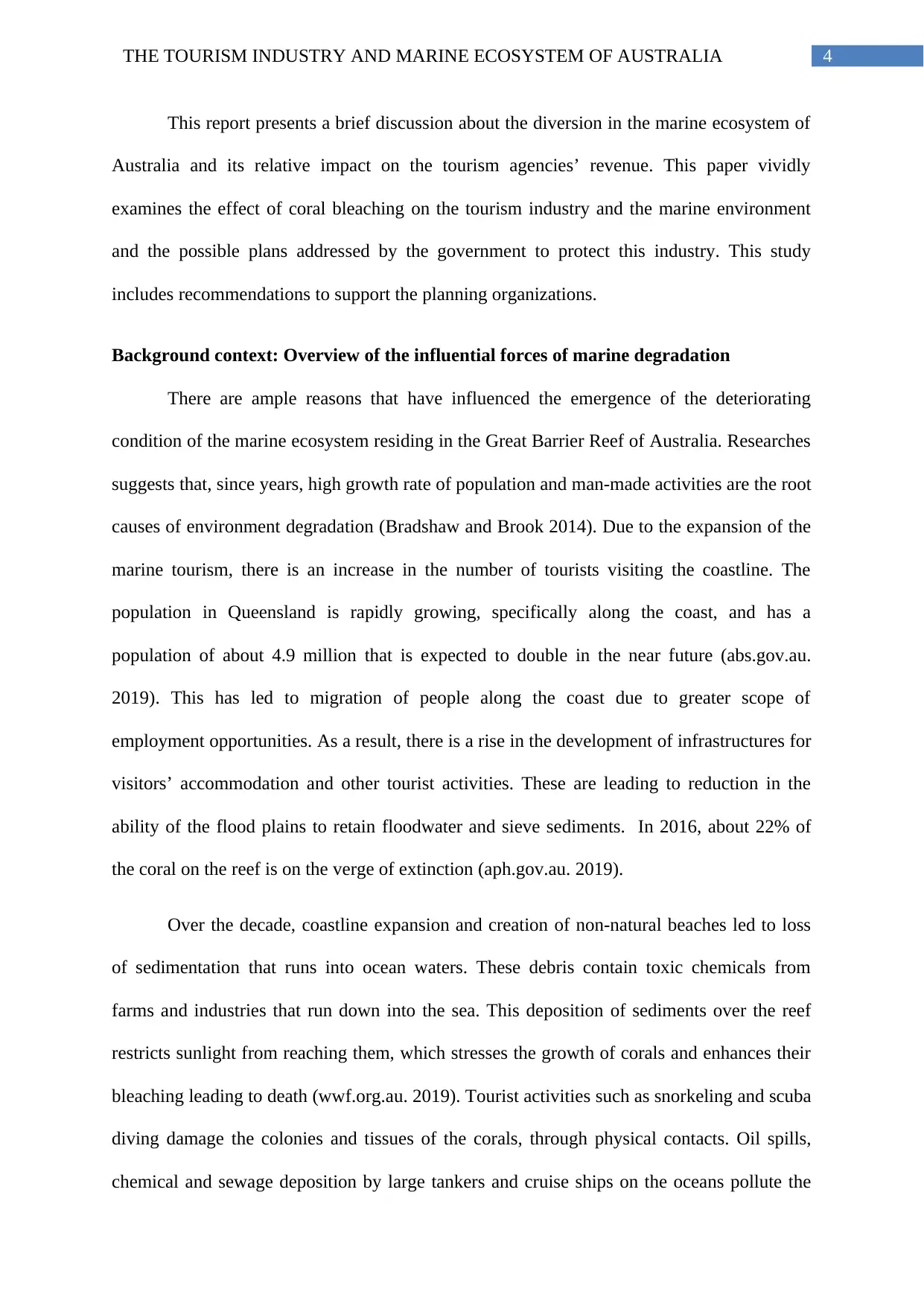
4THE TOURISM INDUSTRY AND MARINE ECOSYSTEM OF AUSTRALIA
This report presents a brief discussion about the diversion in the marine ecosystem of
Australia and its relative impact on the tourism agencies’ revenue. This paper vividly
examines the effect of coral bleaching on the tourism industry and the marine environment
and the possible plans addressed by the government to protect this industry. This study
includes recommendations to support the planning organizations.
Background context: Overview of the influential forces of marine degradation
There are ample reasons that have influenced the emergence of the deteriorating
condition of the marine ecosystem residing in the Great Barrier Reef of Australia. Researches
suggests that, since years, high growth rate of population and man-made activities are the root
causes of environment degradation (Bradshaw and Brook 2014). Due to the expansion of the
marine tourism, there is an increase in the number of tourists visiting the coastline. The
population in Queensland is rapidly growing, specifically along the coast, and has a
population of about 4.9 million that is expected to double in the near future (abs.gov.au.
2019). This has led to migration of people along the coast due to greater scope of
employment opportunities. As a result, there is a rise in the development of infrastructures for
visitors’ accommodation and other tourist activities. These are leading to reduction in the
ability of the flood plains to retain floodwater and sieve sediments. In 2016, about 22% of
the coral on the reef is on the verge of extinction (aph.gov.au. 2019).
Over the decade, coastline expansion and creation of non-natural beaches led to loss
of sedimentation that runs into ocean waters. These debris contain toxic chemicals from
farms and industries that run down into the sea. This deposition of sediments over the reef
restricts sunlight from reaching them, which stresses the growth of corals and enhances their
bleaching leading to death (wwf.org.au. 2019). Tourist activities such as snorkeling and scuba
diving damage the colonies and tissues of the corals, through physical contacts. Oil spills,
chemical and sewage deposition by large tankers and cruise ships on the oceans pollute the
This report presents a brief discussion about the diversion in the marine ecosystem of
Australia and its relative impact on the tourism agencies’ revenue. This paper vividly
examines the effect of coral bleaching on the tourism industry and the marine environment
and the possible plans addressed by the government to protect this industry. This study
includes recommendations to support the planning organizations.
Background context: Overview of the influential forces of marine degradation
There are ample reasons that have influenced the emergence of the deteriorating
condition of the marine ecosystem residing in the Great Barrier Reef of Australia. Researches
suggests that, since years, high growth rate of population and man-made activities are the root
causes of environment degradation (Bradshaw and Brook 2014). Due to the expansion of the
marine tourism, there is an increase in the number of tourists visiting the coastline. The
population in Queensland is rapidly growing, specifically along the coast, and has a
population of about 4.9 million that is expected to double in the near future (abs.gov.au.
2019). This has led to migration of people along the coast due to greater scope of
employment opportunities. As a result, there is a rise in the development of infrastructures for
visitors’ accommodation and other tourist activities. These are leading to reduction in the
ability of the flood plains to retain floodwater and sieve sediments. In 2016, about 22% of
the coral on the reef is on the verge of extinction (aph.gov.au. 2019).
Over the decade, coastline expansion and creation of non-natural beaches led to loss
of sedimentation that runs into ocean waters. These debris contain toxic chemicals from
farms and industries that run down into the sea. This deposition of sediments over the reef
restricts sunlight from reaching them, which stresses the growth of corals and enhances their
bleaching leading to death (wwf.org.au. 2019). Tourist activities such as snorkeling and scuba
diving damage the colonies and tissues of the corals, through physical contacts. Oil spills,
chemical and sewage deposition by large tankers and cruise ships on the oceans pollute the
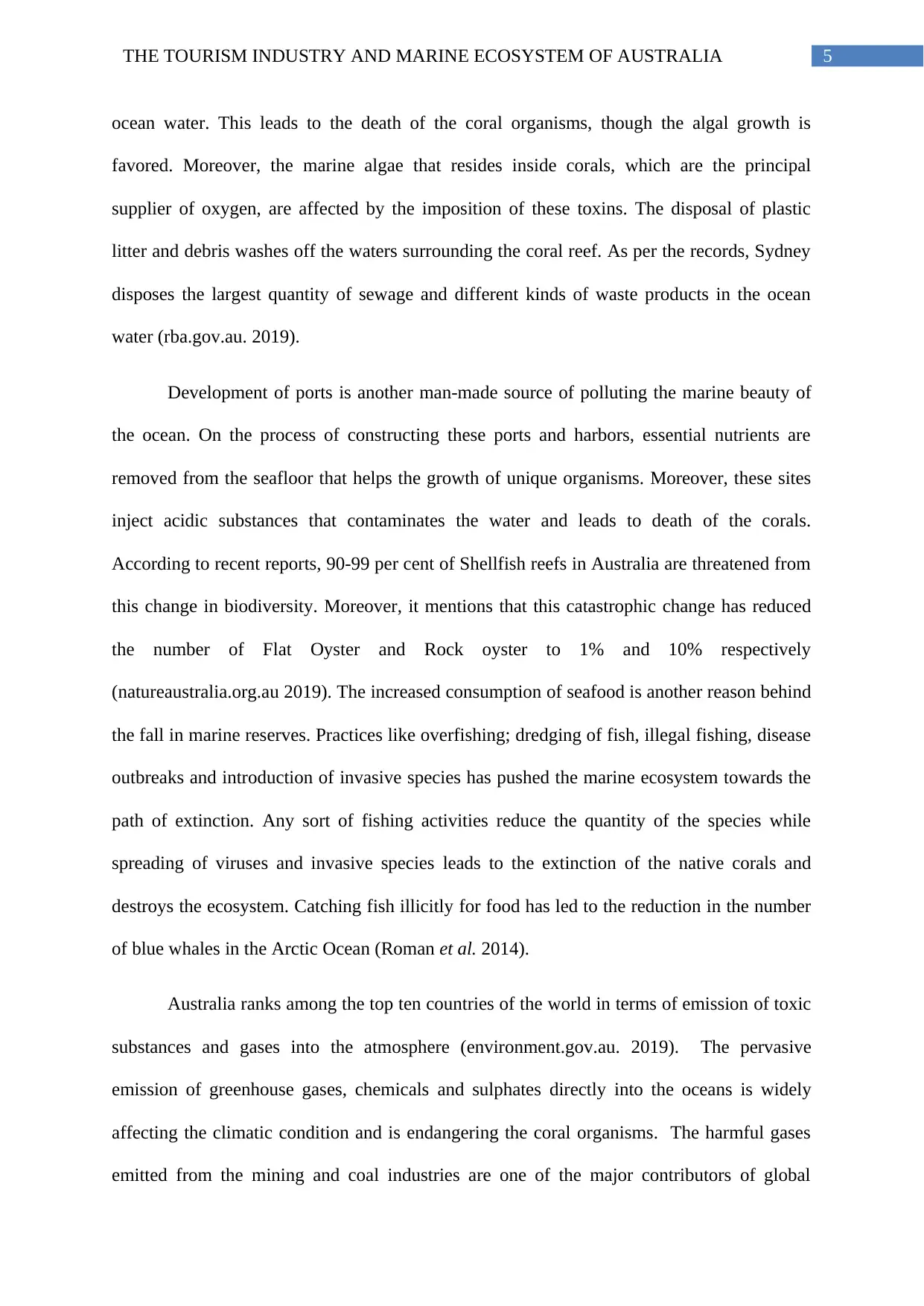
5THE TOURISM INDUSTRY AND MARINE ECOSYSTEM OF AUSTRALIA
ocean water. This leads to the death of the coral organisms, though the algal growth is
favored. Moreover, the marine algae that resides inside corals, which are the principal
supplier of oxygen, are affected by the imposition of these toxins. The disposal of plastic
litter and debris washes off the waters surrounding the coral reef. As per the records, Sydney
disposes the largest quantity of sewage and different kinds of waste products in the ocean
water (rba.gov.au. 2019).
Development of ports is another man-made source of polluting the marine beauty of
the ocean. On the process of constructing these ports and harbors, essential nutrients are
removed from the seafloor that helps the growth of unique organisms. Moreover, these sites
inject acidic substances that contaminates the water and leads to death of the corals.
According to recent reports, 90-99 per cent of Shellfish reefs in Australia are threatened from
this change in biodiversity. Moreover, it mentions that this catastrophic change has reduced
the number of Flat Oyster and Rock oyster to 1% and 10% respectively
(natureaustralia.org.au 2019). The increased consumption of seafood is another reason behind
the fall in marine reserves. Practices like overfishing; dredging of fish, illegal fishing, disease
outbreaks and introduction of invasive species has pushed the marine ecosystem towards the
path of extinction. Any sort of fishing activities reduce the quantity of the species while
spreading of viruses and invasive species leads to the extinction of the native corals and
destroys the ecosystem. Catching fish illicitly for food has led to the reduction in the number
of blue whales in the Arctic Ocean (Roman et al. 2014).
Australia ranks among the top ten countries of the world in terms of emission of toxic
substances and gases into the atmosphere (environment.gov.au. 2019). The pervasive
emission of greenhouse gases, chemicals and sulphates directly into the oceans is widely
affecting the climatic condition and is endangering the coral organisms. The harmful gases
emitted from the mining and coal industries are one of the major contributors of global
ocean water. This leads to the death of the coral organisms, though the algal growth is
favored. Moreover, the marine algae that resides inside corals, which are the principal
supplier of oxygen, are affected by the imposition of these toxins. The disposal of plastic
litter and debris washes off the waters surrounding the coral reef. As per the records, Sydney
disposes the largest quantity of sewage and different kinds of waste products in the ocean
water (rba.gov.au. 2019).
Development of ports is another man-made source of polluting the marine beauty of
the ocean. On the process of constructing these ports and harbors, essential nutrients are
removed from the seafloor that helps the growth of unique organisms. Moreover, these sites
inject acidic substances that contaminates the water and leads to death of the corals.
According to recent reports, 90-99 per cent of Shellfish reefs in Australia are threatened from
this change in biodiversity. Moreover, it mentions that this catastrophic change has reduced
the number of Flat Oyster and Rock oyster to 1% and 10% respectively
(natureaustralia.org.au 2019). The increased consumption of seafood is another reason behind
the fall in marine reserves. Practices like overfishing; dredging of fish, illegal fishing, disease
outbreaks and introduction of invasive species has pushed the marine ecosystem towards the
path of extinction. Any sort of fishing activities reduce the quantity of the species while
spreading of viruses and invasive species leads to the extinction of the native corals and
destroys the ecosystem. Catching fish illicitly for food has led to the reduction in the number
of blue whales in the Arctic Ocean (Roman et al. 2014).
Australia ranks among the top ten countries of the world in terms of emission of toxic
substances and gases into the atmosphere (environment.gov.au. 2019). The pervasive
emission of greenhouse gases, chemicals and sulphates directly into the oceans is widely
affecting the climatic condition and is endangering the coral organisms. The harmful gases
emitted from the mining and coal industries are one of the major contributors of global

6THE TOURISM INDUSTRY AND MARINE ECOSYSTEM OF AUSTRALIA
warming. Moreover, majority of the electricity supply generated to run Australia is obtained
from the coal industry. Hence, this has resulted into emission of CO2 in the environment
risking the marine habitat of this country (Head, 2014). In the past 200 years, ocean is known
to absorb one-third of the carbon dioxide released in the air (abc.net.au 2018). These are
adding to the causes of rise in acid concentration in the water and rising temperatures. This
change in climatic conditions is responsible for increase in the water temperatures of the
ocean. This is the principal contemporary reason for reduction in coral habitats in the Great
Barrier Reef of Australia.
Apart from reasons like artificial and climatic changes, a number of natural calamities
affects the World Heritage site of Australia. Disasters like tropical cyclones and King tides
possesses severe and extensive damage to coral reef. In 2011, Cyclone Yasi broke a large part
of the Great Barrier Reef (Dwyer et al. 2013). This has greatly damaged the marine life of the
area surrounding this reef. Heavy rainfall and floods increase the volume of debris and
terrestrial materials being deposited in the ocean. This stagnates the growth of coral
organisms.
warming. Moreover, majority of the electricity supply generated to run Australia is obtained
from the coal industry. Hence, this has resulted into emission of CO2 in the environment
risking the marine habitat of this country (Head, 2014). In the past 200 years, ocean is known
to absorb one-third of the carbon dioxide released in the air (abc.net.au 2018). These are
adding to the causes of rise in acid concentration in the water and rising temperatures. This
change in climatic conditions is responsible for increase in the water temperatures of the
ocean. This is the principal contemporary reason for reduction in coral habitats in the Great
Barrier Reef of Australia.
Apart from reasons like artificial and climatic changes, a number of natural calamities
affects the World Heritage site of Australia. Disasters like tropical cyclones and King tides
possesses severe and extensive damage to coral reef. In 2011, Cyclone Yasi broke a large part
of the Great Barrier Reef (Dwyer et al. 2013). This has greatly damaged the marine life of the
area surrounding this reef. Heavy rainfall and floods increase the volume of debris and
terrestrial materials being deposited in the ocean. This stagnates the growth of coral
organisms.
Paraphrase This Document
Need a fresh take? Get an instant paraphrase of this document with our AI Paraphraser
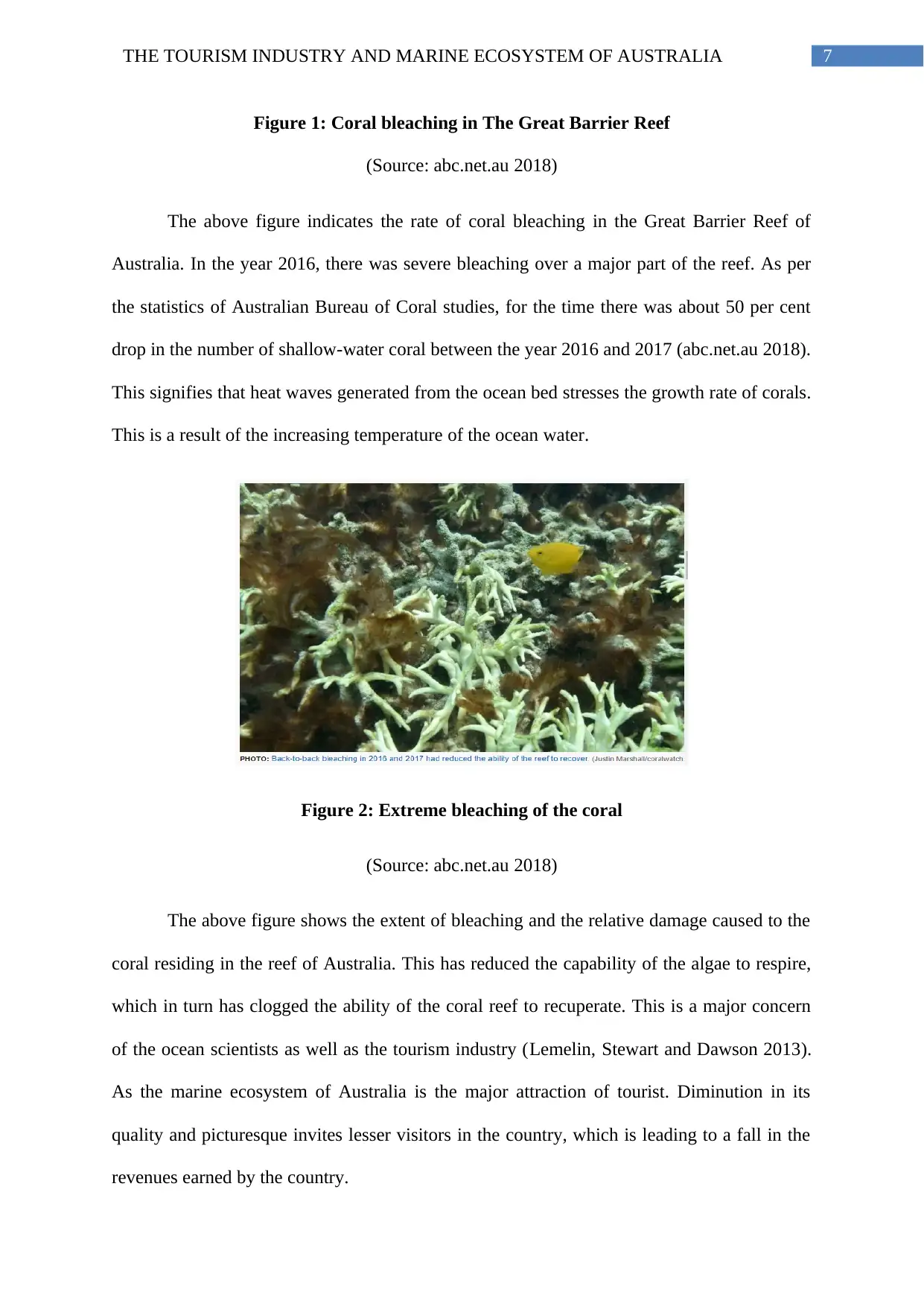
7THE TOURISM INDUSTRY AND MARINE ECOSYSTEM OF AUSTRALIA
Figure 1: Coral bleaching in The Great Barrier Reef
(Source: abc.net.au 2018)
The above figure indicates the rate of coral bleaching in the Great Barrier Reef of
Australia. In the year 2016, there was severe bleaching over a major part of the reef. As per
the statistics of Australian Bureau of Coral studies, for the time there was about 50 per cent
drop in the number of shallow-water coral between the year 2016 and 2017 (abc.net.au 2018).
This signifies that heat waves generated from the ocean bed stresses the growth rate of corals.
This is a result of the increasing temperature of the ocean water.
Figure 2: Extreme bleaching of the coral
(Source: abc.net.au 2018)
The above figure shows the extent of bleaching and the relative damage caused to the
coral residing in the reef of Australia. This has reduced the capability of the algae to respire,
which in turn has clogged the ability of the coral reef to recuperate. This is a major concern
of the ocean scientists as well as the tourism industry (Lemelin, Stewart and Dawson 2013).
As the marine ecosystem of Australia is the major attraction of tourist. Diminution in its
quality and picturesque invites lesser visitors in the country, which is leading to a fall in the
revenues earned by the country.
Figure 1: Coral bleaching in The Great Barrier Reef
(Source: abc.net.au 2018)
The above figure indicates the rate of coral bleaching in the Great Barrier Reef of
Australia. In the year 2016, there was severe bleaching over a major part of the reef. As per
the statistics of Australian Bureau of Coral studies, for the time there was about 50 per cent
drop in the number of shallow-water coral between the year 2016 and 2017 (abc.net.au 2018).
This signifies that heat waves generated from the ocean bed stresses the growth rate of corals.
This is a result of the increasing temperature of the ocean water.
Figure 2: Extreme bleaching of the coral
(Source: abc.net.au 2018)
The above figure shows the extent of bleaching and the relative damage caused to the
coral residing in the reef of Australia. This has reduced the capability of the algae to respire,
which in turn has clogged the ability of the coral reef to recuperate. This is a major concern
of the ocean scientists as well as the tourism industry (Lemelin, Stewart and Dawson 2013).
As the marine ecosystem of Australia is the major attraction of tourist. Diminution in its
quality and picturesque invites lesser visitors in the country, which is leading to a fall in the
revenues earned by the country.
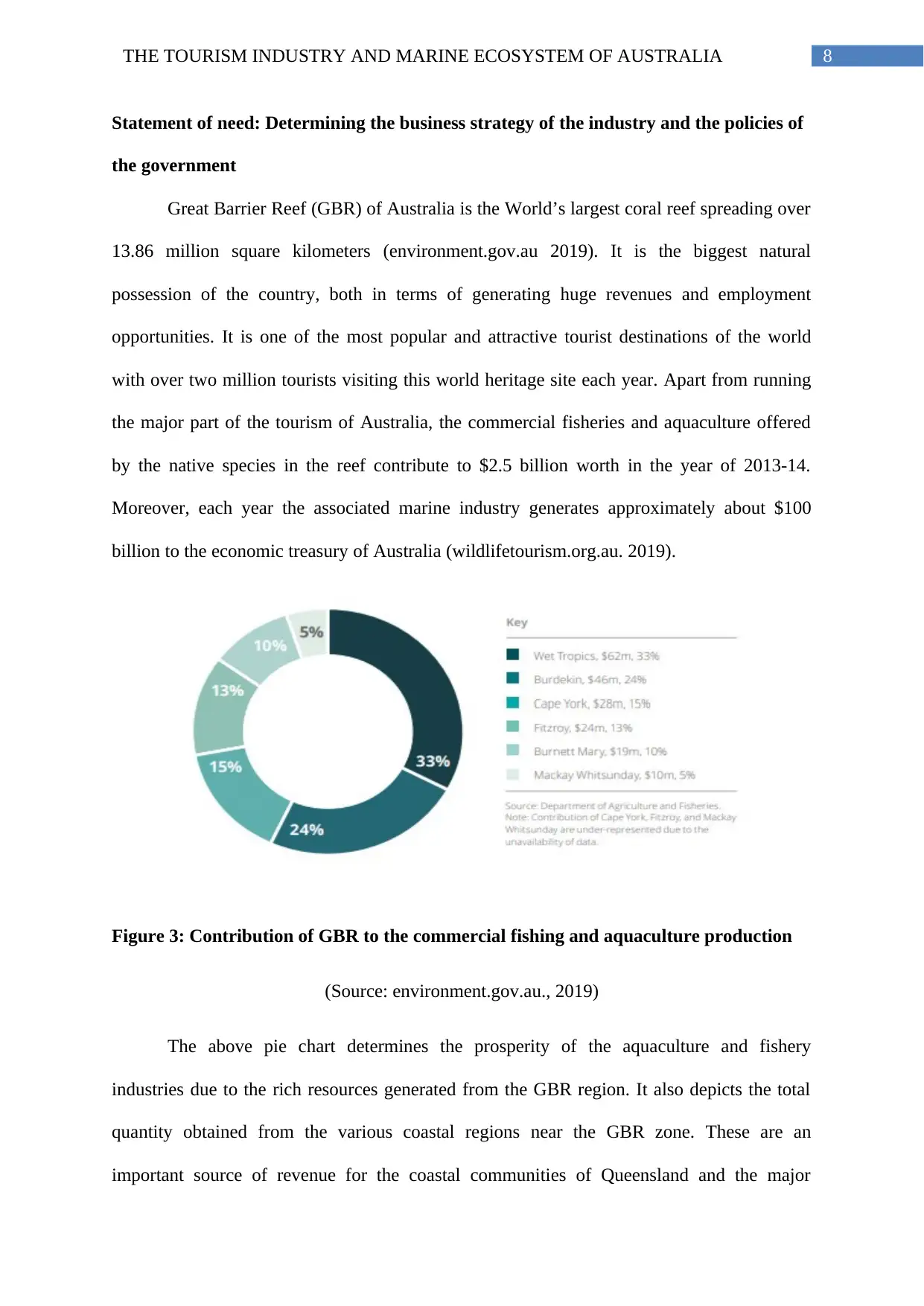
8THE TOURISM INDUSTRY AND MARINE ECOSYSTEM OF AUSTRALIA
Statement of need: Determining the business strategy of the industry and the policies of
the government
Great Barrier Reef (GBR) of Australia is the World’s largest coral reef spreading over
13.86 million square kilometers (environment.gov.au 2019). It is the biggest natural
possession of the country, both in terms of generating huge revenues and employment
opportunities. It is one of the most popular and attractive tourist destinations of the world
with over two million tourists visiting this world heritage site each year. Apart from running
the major part of the tourism of Australia, the commercial fisheries and aquaculture offered
by the native species in the reef contribute to $2.5 billion worth in the year of 2013-14.
Moreover, each year the associated marine industry generates approximately about $100
billion to the economic treasury of Australia (wildlifetourism.org.au. 2019).
Figure 3: Contribution of GBR to the commercial fishing and aquaculture production
(Source: environment.gov.au., 2019)
The above pie chart determines the prosperity of the aquaculture and fishery
industries due to the rich resources generated from the GBR region. It also depicts the total
quantity obtained from the various coastal regions near the GBR zone. These are an
important source of revenue for the coastal communities of Queensland and the major
Statement of need: Determining the business strategy of the industry and the policies of
the government
Great Barrier Reef (GBR) of Australia is the World’s largest coral reef spreading over
13.86 million square kilometers (environment.gov.au 2019). It is the biggest natural
possession of the country, both in terms of generating huge revenues and employment
opportunities. It is one of the most popular and attractive tourist destinations of the world
with over two million tourists visiting this world heritage site each year. Apart from running
the major part of the tourism of Australia, the commercial fisheries and aquaculture offered
by the native species in the reef contribute to $2.5 billion worth in the year of 2013-14.
Moreover, each year the associated marine industry generates approximately about $100
billion to the economic treasury of Australia (wildlifetourism.org.au. 2019).
Figure 3: Contribution of GBR to the commercial fishing and aquaculture production
(Source: environment.gov.au., 2019)
The above pie chart determines the prosperity of the aquaculture and fishery
industries due to the rich resources generated from the GBR region. It also depicts the total
quantity obtained from the various coastal regions near the GBR zone. These are an
important source of revenue for the coastal communities of Queensland and the major
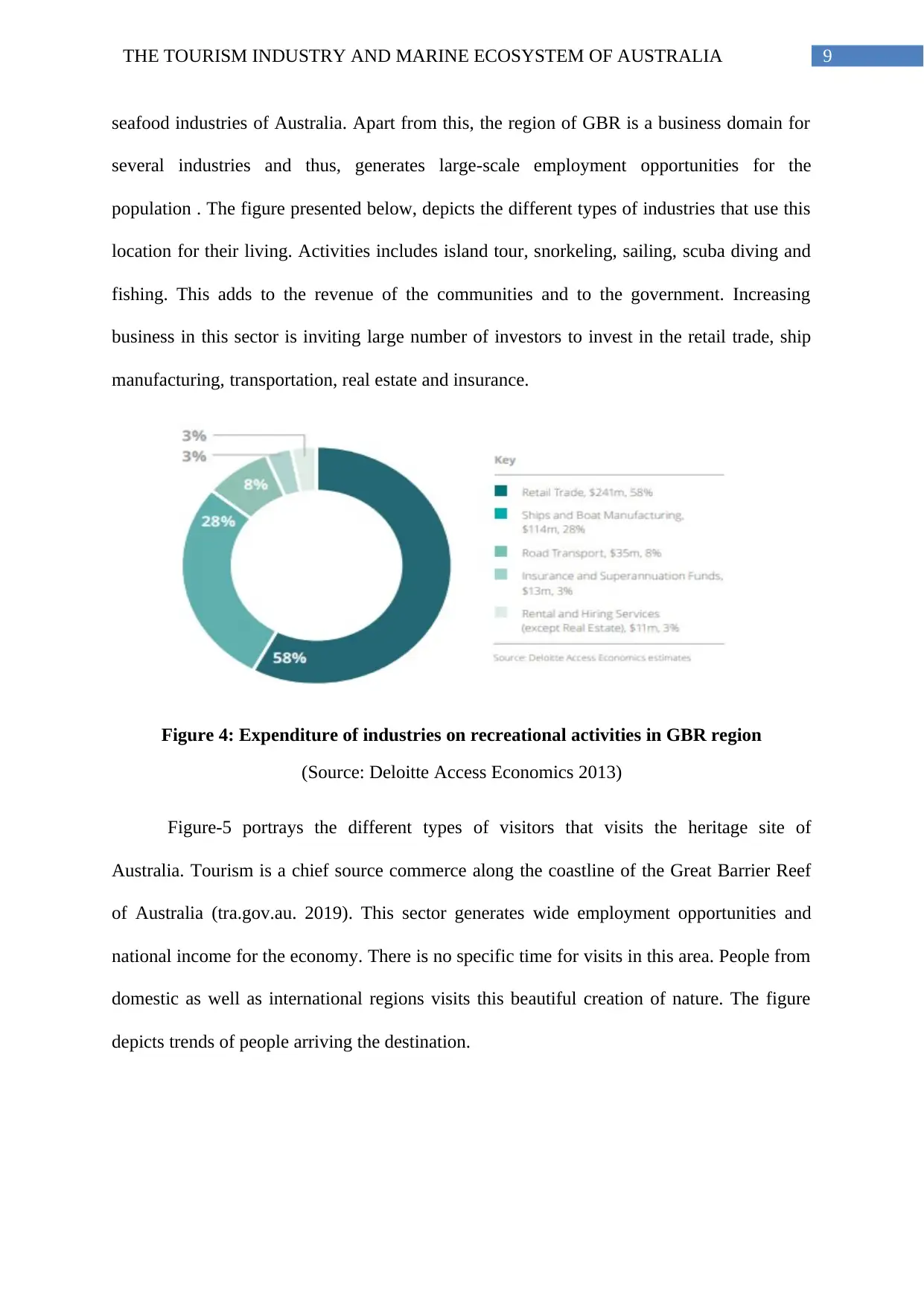
9THE TOURISM INDUSTRY AND MARINE ECOSYSTEM OF AUSTRALIA
seafood industries of Australia. Apart from this, the region of GBR is a business domain for
several industries and thus, generates large-scale employment opportunities for the
population . The figure presented below, depicts the different types of industries that use this
location for their living. Activities includes island tour, snorkeling, sailing, scuba diving and
fishing. This adds to the revenue of the communities and to the government. Increasing
business in this sector is inviting large number of investors to invest in the retail trade, ship
manufacturing, transportation, real estate and insurance.
Figure 4: Expenditure of industries on recreational activities in GBR region
(Source: Deloitte Access Economics 2013)
Figure-5 portrays the different types of visitors that visits the heritage site of
Australia. Tourism is a chief source commerce along the coastline of the Great Barrier Reef
of Australia (tra.gov.au. 2019). This sector generates wide employment opportunities and
national income for the economy. There is no specific time for visits in this area. People from
domestic as well as international regions visits this beautiful creation of nature. The figure
depicts trends of people arriving the destination.
seafood industries of Australia. Apart from this, the region of GBR is a business domain for
several industries and thus, generates large-scale employment opportunities for the
population . The figure presented below, depicts the different types of industries that use this
location for their living. Activities includes island tour, snorkeling, sailing, scuba diving and
fishing. This adds to the revenue of the communities and to the government. Increasing
business in this sector is inviting large number of investors to invest in the retail trade, ship
manufacturing, transportation, real estate and insurance.
Figure 4: Expenditure of industries on recreational activities in GBR region
(Source: Deloitte Access Economics 2013)
Figure-5 portrays the different types of visitors that visits the heritage site of
Australia. Tourism is a chief source commerce along the coastline of the Great Barrier Reef
of Australia (tra.gov.au. 2019). This sector generates wide employment opportunities and
national income for the economy. There is no specific time for visits in this area. People from
domestic as well as international regions visits this beautiful creation of nature. The figure
depicts trends of people arriving the destination.
Secure Best Marks with AI Grader
Need help grading? Try our AI Grader for instant feedback on your assignments.
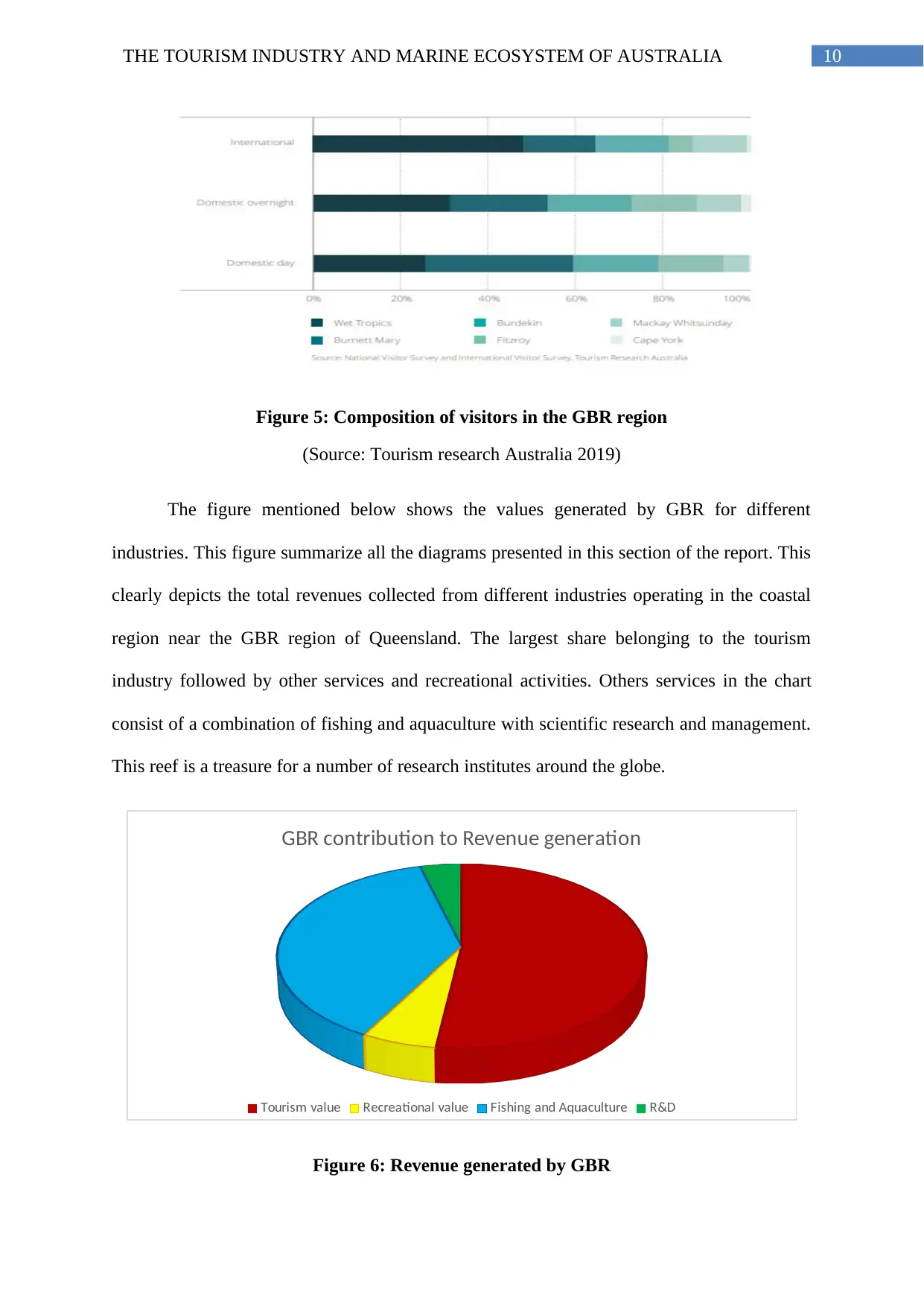
10THE TOURISM INDUSTRY AND MARINE ECOSYSTEM OF AUSTRALIA
Figure 5: Composition of visitors in the GBR region
(Source: Tourism research Australia 2019)
The figure mentioned below shows the values generated by GBR for different
industries. This figure summarize all the diagrams presented in this section of the report. This
clearly depicts the total revenues collected from different industries operating in the coastal
region near the GBR region of Queensland. The largest share belonging to the tourism
industry followed by other services and recreational activities. Others services in the chart
consist of a combination of fishing and aquaculture with scientific research and management.
This reef is a treasure for a number of research institutes around the globe.
GBR contribution to Revenue generation
Tourism value Recreational value Fishing and Aquaculture R&D
Figure 6: Revenue generated by GBR
Figure 5: Composition of visitors in the GBR region
(Source: Tourism research Australia 2019)
The figure mentioned below shows the values generated by GBR for different
industries. This figure summarize all the diagrams presented in this section of the report. This
clearly depicts the total revenues collected from different industries operating in the coastal
region near the GBR region of Queensland. The largest share belonging to the tourism
industry followed by other services and recreational activities. Others services in the chart
consist of a combination of fishing and aquaculture with scientific research and management.
This reef is a treasure for a number of research institutes around the globe.
GBR contribution to Revenue generation
Tourism value Recreational value Fishing and Aquaculture R&D
Figure 6: Revenue generated by GBR

11THE TOURISM INDUSTRY AND MARINE ECOSYSTEM OF AUSTRALIA
(Source: Created by Author)
Apart from providing huge amount of income to the nation, the Reef of Australia
provides various non-monetary benefits to the environment. Provided the current pressure
and degradation faced by the GBR and marine biodiversity, both the tourism sector along
with the government of Australia should take initiatives in order to mitigate these pressures.
In 2011, the UNESCO World Heritage Committee requested Australian government to
undertake severe comprehensive measures to protect the Reef (Fidelman Leitch and Nelson
2013). The Australian state and territory jurisdiction has implemented new set of regulations
to benefit the marine environment of the country. Policies such as the Integrated Marine
Observing System, the Long-term Temperate Marine Protected Area Monitoring Program
and the Australian Institute of Marine Science Long-term Monitoring Program are designed
by the authorities to protect this area to hold the interests of the stakeholders and the
expectations of the visitors (Fitzsimons et al. 2015). These policies are designed to discover
new ideas to regenerate the ability of the Reef to cure itself. Several institutes regularly
monitor the status of the Reef to note its current stage of improvement. Government has
declared certain region of the Reef to be restricted for visitors and other activities that can
damage the ecology. Other than these measures, the government of Australia and Queensland
together in 2015 imposed a ban on sea dumping of capital dredge spoil in the ocean and in the
area near the GBR (Vince and Hardesty 2017).
The authority of Queensland has legislated to restrict dredging by major capital ports
in the coastal areas. Moreover, there are regulations for emission of gas and chemicals by
certain industries that are the major contributors of harmful toxins into the atmosphere. The
state authorities have prohibited the farming activities and other agricultural operations that
harms the ability of the land to restrict the floodwater and leads to the formation of toxin
sediments (D’Olivo, McCulloch and Judd 2013). The Australian tourism industry is
(Source: Created by Author)
Apart from providing huge amount of income to the nation, the Reef of Australia
provides various non-monetary benefits to the environment. Provided the current pressure
and degradation faced by the GBR and marine biodiversity, both the tourism sector along
with the government of Australia should take initiatives in order to mitigate these pressures.
In 2011, the UNESCO World Heritage Committee requested Australian government to
undertake severe comprehensive measures to protect the Reef (Fidelman Leitch and Nelson
2013). The Australian state and territory jurisdiction has implemented new set of regulations
to benefit the marine environment of the country. Policies such as the Integrated Marine
Observing System, the Long-term Temperate Marine Protected Area Monitoring Program
and the Australian Institute of Marine Science Long-term Monitoring Program are designed
by the authorities to protect this area to hold the interests of the stakeholders and the
expectations of the visitors (Fitzsimons et al. 2015). These policies are designed to discover
new ideas to regenerate the ability of the Reef to cure itself. Several institutes regularly
monitor the status of the Reef to note its current stage of improvement. Government has
declared certain region of the Reef to be restricted for visitors and other activities that can
damage the ecology. Other than these measures, the government of Australia and Queensland
together in 2015 imposed a ban on sea dumping of capital dredge spoil in the ocean and in the
area near the GBR (Vince and Hardesty 2017).
The authority of Queensland has legislated to restrict dredging by major capital ports
in the coastal areas. Moreover, there are regulations for emission of gas and chemicals by
certain industries that are the major contributors of harmful toxins into the atmosphere. The
state authorities have prohibited the farming activities and other agricultural operations that
harms the ability of the land to restrict the floodwater and leads to the formation of toxin
sediments (D’Olivo, McCulloch and Judd 2013). The Australian tourism industry is
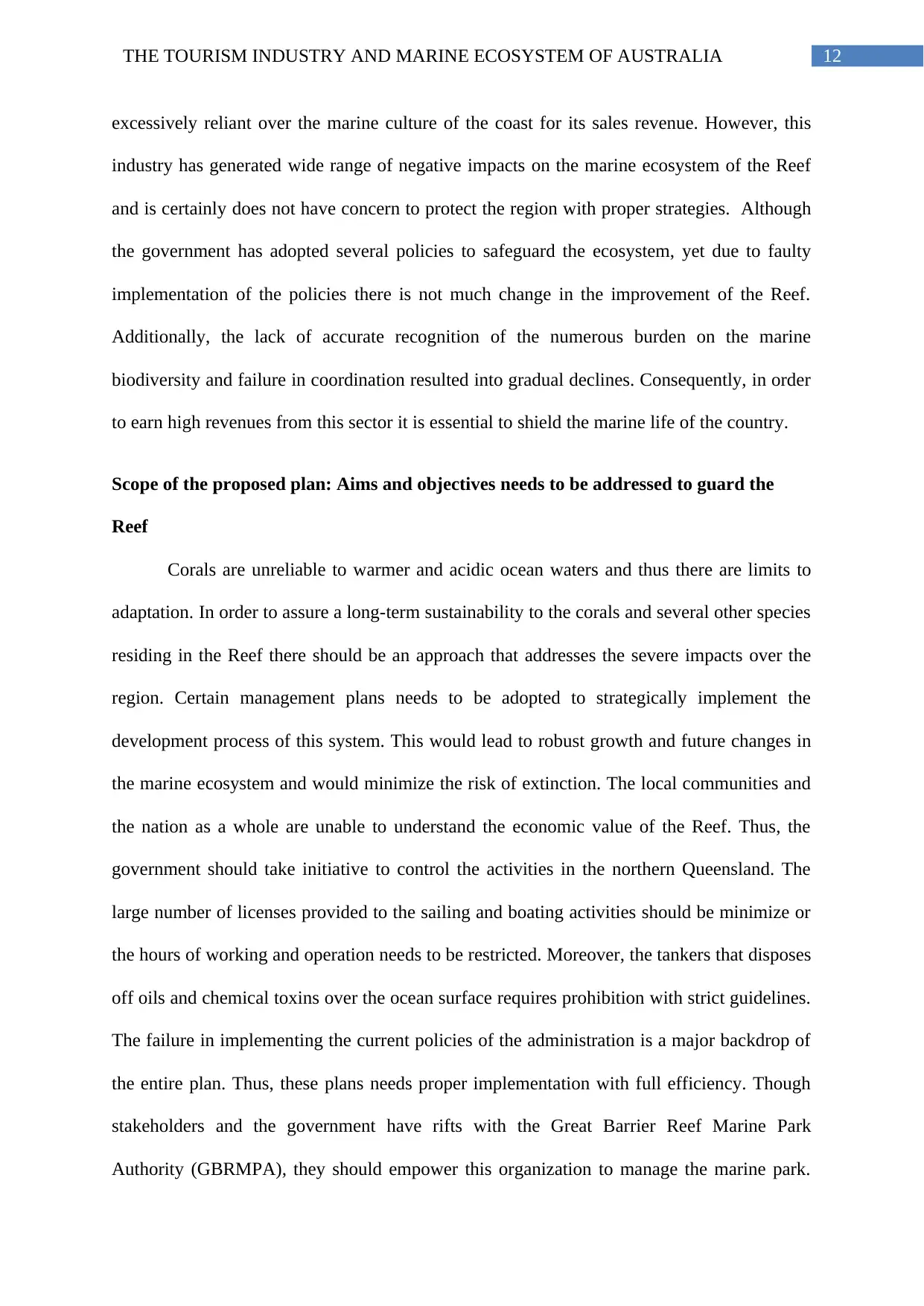
12THE TOURISM INDUSTRY AND MARINE ECOSYSTEM OF AUSTRALIA
excessively reliant over the marine culture of the coast for its sales revenue. However, this
industry has generated wide range of negative impacts on the marine ecosystem of the Reef
and is certainly does not have concern to protect the region with proper strategies. Although
the government has adopted several policies to safeguard the ecosystem, yet due to faulty
implementation of the policies there is not much change in the improvement of the Reef.
Additionally, the lack of accurate recognition of the numerous burden on the marine
biodiversity and failure in coordination resulted into gradual declines. Consequently, in order
to earn high revenues from this sector it is essential to shield the marine life of the country.
Scope of the proposed plan: Aims and objectives needs to be addressed to guard the
Reef
Corals are unreliable to warmer and acidic ocean waters and thus there are limits to
adaptation. In order to assure a long-term sustainability to the corals and several other species
residing in the Reef there should be an approach that addresses the severe impacts over the
region. Certain management plans needs to be adopted to strategically implement the
development process of this system. This would lead to robust growth and future changes in
the marine ecosystem and would minimize the risk of extinction. The local communities and
the nation as a whole are unable to understand the economic value of the Reef. Thus, the
government should take initiative to control the activities in the northern Queensland. The
large number of licenses provided to the sailing and boating activities should be minimize or
the hours of working and operation needs to be restricted. Moreover, the tankers that disposes
off oils and chemical toxins over the ocean surface requires prohibition with strict guidelines.
The failure in implementing the current policies of the administration is a major backdrop of
the entire plan. Thus, these plans needs proper implementation with full efficiency. Though
stakeholders and the government have rifts with the Great Barrier Reef Marine Park
Authority (GBRMPA), they should empower this organization to manage the marine park.
excessively reliant over the marine culture of the coast for its sales revenue. However, this
industry has generated wide range of negative impacts on the marine ecosystem of the Reef
and is certainly does not have concern to protect the region with proper strategies. Although
the government has adopted several policies to safeguard the ecosystem, yet due to faulty
implementation of the policies there is not much change in the improvement of the Reef.
Additionally, the lack of accurate recognition of the numerous burden on the marine
biodiversity and failure in coordination resulted into gradual declines. Consequently, in order
to earn high revenues from this sector it is essential to shield the marine life of the country.
Scope of the proposed plan: Aims and objectives needs to be addressed to guard the
Reef
Corals are unreliable to warmer and acidic ocean waters and thus there are limits to
adaptation. In order to assure a long-term sustainability to the corals and several other species
residing in the Reef there should be an approach that addresses the severe impacts over the
region. Certain management plans needs to be adopted to strategically implement the
development process of this system. This would lead to robust growth and future changes in
the marine ecosystem and would minimize the risk of extinction. The local communities and
the nation as a whole are unable to understand the economic value of the Reef. Thus, the
government should take initiative to control the activities in the northern Queensland. The
large number of licenses provided to the sailing and boating activities should be minimize or
the hours of working and operation needs to be restricted. Moreover, the tankers that disposes
off oils and chemical toxins over the ocean surface requires prohibition with strict guidelines.
The failure in implementing the current policies of the administration is a major backdrop of
the entire plan. Thus, these plans needs proper implementation with full efficiency. Though
stakeholders and the government have rifts with the Great Barrier Reef Marine Park
Authority (GBRMPA), they should empower this organization to manage the marine park.
Paraphrase This Document
Need a fresh take? Get an instant paraphrase of this document with our AI Paraphraser
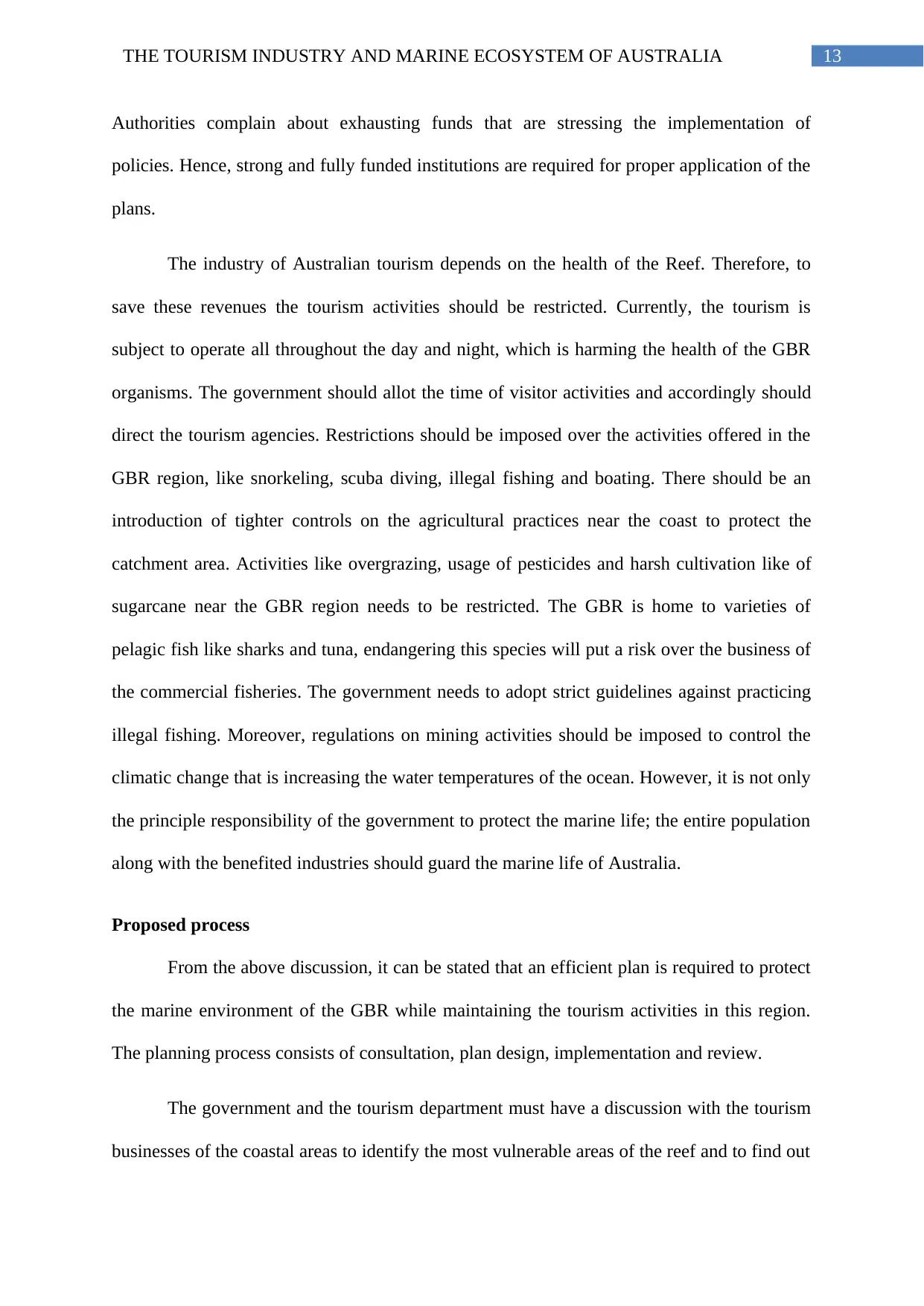
13THE TOURISM INDUSTRY AND MARINE ECOSYSTEM OF AUSTRALIA
Authorities complain about exhausting funds that are stressing the implementation of
policies. Hence, strong and fully funded institutions are required for proper application of the
plans.
The industry of Australian tourism depends on the health of the Reef. Therefore, to
save these revenues the tourism activities should be restricted. Currently, the tourism is
subject to operate all throughout the day and night, which is harming the health of the GBR
organisms. The government should allot the time of visitor activities and accordingly should
direct the tourism agencies. Restrictions should be imposed over the activities offered in the
GBR region, like snorkeling, scuba diving, illegal fishing and boating. There should be an
introduction of tighter controls on the agricultural practices near the coast to protect the
catchment area. Activities like overgrazing, usage of pesticides and harsh cultivation like of
sugarcane near the GBR region needs to be restricted. The GBR is home to varieties of
pelagic fish like sharks and tuna, endangering this species will put a risk over the business of
the commercial fisheries. The government needs to adopt strict guidelines against practicing
illegal fishing. Moreover, regulations on mining activities should be imposed to control the
climatic change that is increasing the water temperatures of the ocean. However, it is not only
the principle responsibility of the government to protect the marine life; the entire population
along with the benefited industries should guard the marine life of Australia.
Proposed process
From the above discussion, it can be stated that an efficient plan is required to protect
the marine environment of the GBR while maintaining the tourism activities in this region.
The planning process consists of consultation, plan design, implementation and review.
The government and the tourism department must have a discussion with the tourism
businesses of the coastal areas to identify the most vulnerable areas of the reef and to find out
Authorities complain about exhausting funds that are stressing the implementation of
policies. Hence, strong and fully funded institutions are required for proper application of the
plans.
The industry of Australian tourism depends on the health of the Reef. Therefore, to
save these revenues the tourism activities should be restricted. Currently, the tourism is
subject to operate all throughout the day and night, which is harming the health of the GBR
organisms. The government should allot the time of visitor activities and accordingly should
direct the tourism agencies. Restrictions should be imposed over the activities offered in the
GBR region, like snorkeling, scuba diving, illegal fishing and boating. There should be an
introduction of tighter controls on the agricultural practices near the coast to protect the
catchment area. Activities like overgrazing, usage of pesticides and harsh cultivation like of
sugarcane near the GBR region needs to be restricted. The GBR is home to varieties of
pelagic fish like sharks and tuna, endangering this species will put a risk over the business of
the commercial fisheries. The government needs to adopt strict guidelines against practicing
illegal fishing. Moreover, regulations on mining activities should be imposed to control the
climatic change that is increasing the water temperatures of the ocean. However, it is not only
the principle responsibility of the government to protect the marine life; the entire population
along with the benefited industries should guard the marine life of Australia.
Proposed process
From the above discussion, it can be stated that an efficient plan is required to protect
the marine environment of the GBR while maintaining the tourism activities in this region.
The planning process consists of consultation, plan design, implementation and review.
The government and the tourism department must have a discussion with the tourism
businesses of the coastal areas to identify the most vulnerable areas of the reef and to find out
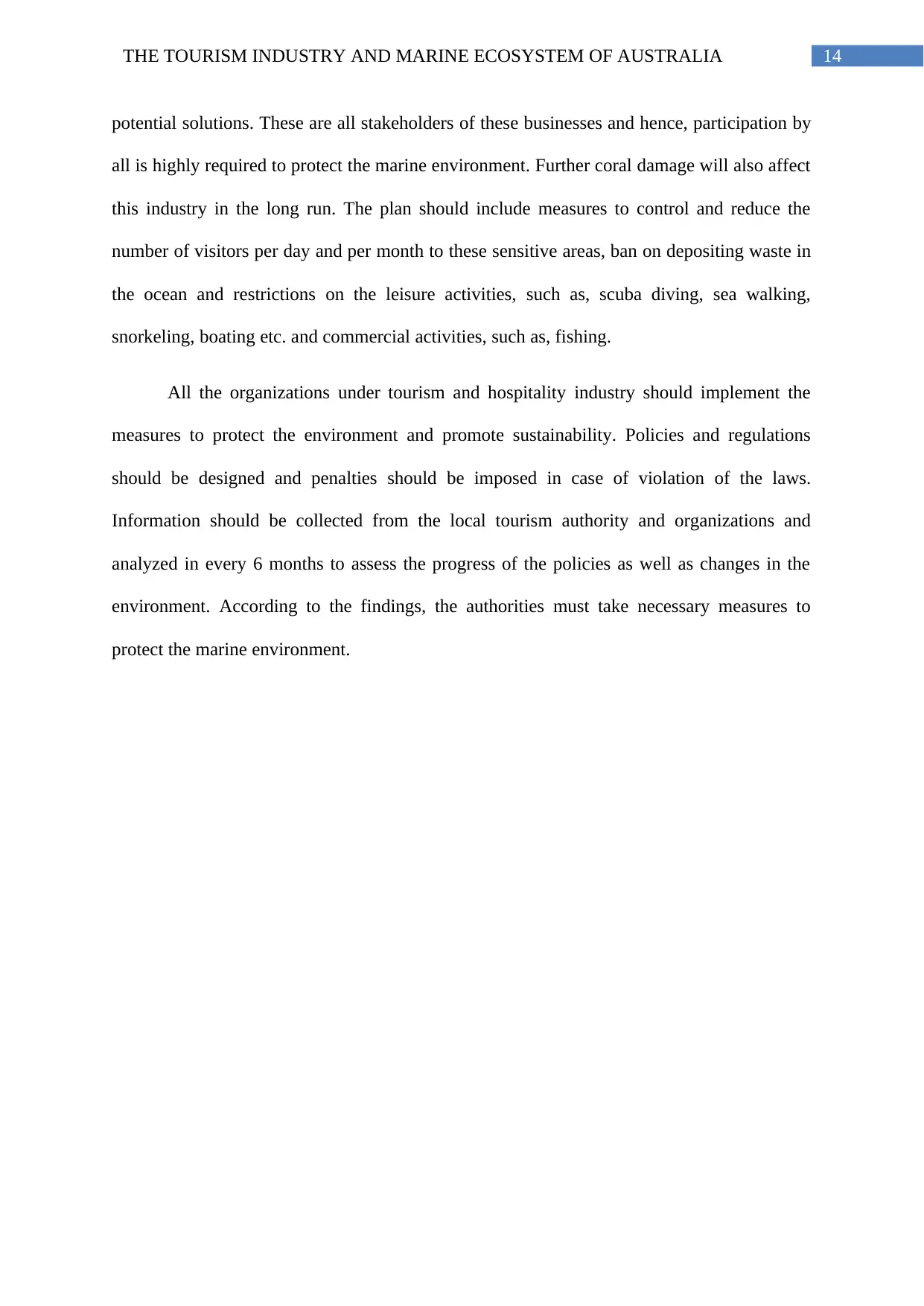
14THE TOURISM INDUSTRY AND MARINE ECOSYSTEM OF AUSTRALIA
potential solutions. These are all stakeholders of these businesses and hence, participation by
all is highly required to protect the marine environment. Further coral damage will also affect
this industry in the long run. The plan should include measures to control and reduce the
number of visitors per day and per month to these sensitive areas, ban on depositing waste in
the ocean and restrictions on the leisure activities, such as, scuba diving, sea walking,
snorkeling, boating etc. and commercial activities, such as, fishing.
All the organizations under tourism and hospitality industry should implement the
measures to protect the environment and promote sustainability. Policies and regulations
should be designed and penalties should be imposed in case of violation of the laws.
Information should be collected from the local tourism authority and organizations and
analyzed in every 6 months to assess the progress of the policies as well as changes in the
environment. According to the findings, the authorities must take necessary measures to
protect the marine environment.
potential solutions. These are all stakeholders of these businesses and hence, participation by
all is highly required to protect the marine environment. Further coral damage will also affect
this industry in the long run. The plan should include measures to control and reduce the
number of visitors per day and per month to these sensitive areas, ban on depositing waste in
the ocean and restrictions on the leisure activities, such as, scuba diving, sea walking,
snorkeling, boating etc. and commercial activities, such as, fishing.
All the organizations under tourism and hospitality industry should implement the
measures to protect the environment and promote sustainability. Policies and regulations
should be designed and penalties should be imposed in case of violation of the laws.
Information should be collected from the local tourism authority and organizations and
analyzed in every 6 months to assess the progress of the policies as well as changes in the
environment. According to the findings, the authorities must take necessary measures to
protect the marine environment.
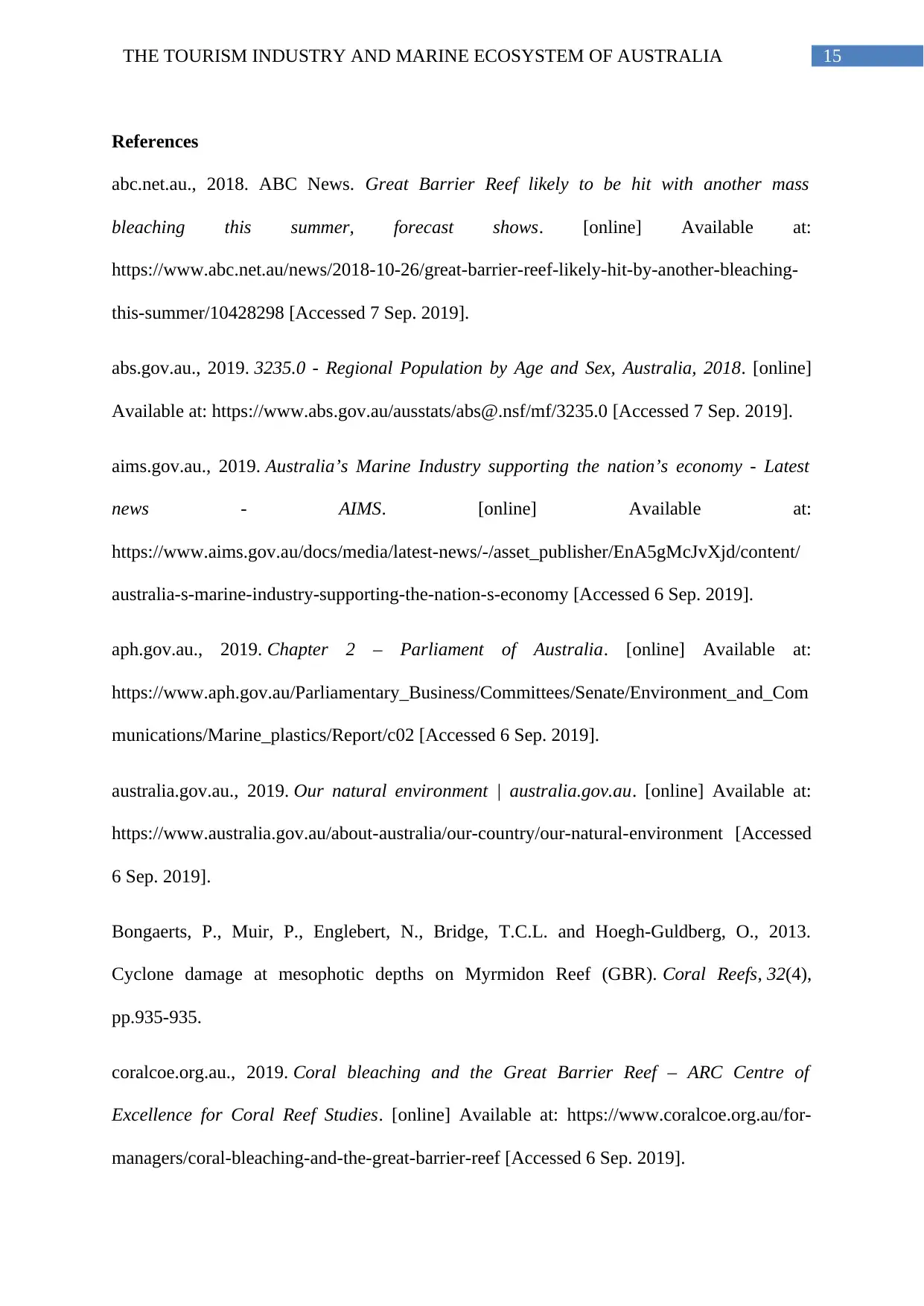
15THE TOURISM INDUSTRY AND MARINE ECOSYSTEM OF AUSTRALIA
References
abc.net.au., 2018. ABC News. Great Barrier Reef likely to be hit with another mass
bleaching this summer, forecast shows. [online] Available at:
https://www.abc.net.au/news/2018-10-26/great-barrier-reef-likely-hit-by-another-bleaching-
this-summer/10428298 [Accessed 7 Sep. 2019].
abs.gov.au., 2019. 3235.0 - Regional Population by Age and Sex, Australia, 2018. [online]
Available at: https://www.abs.gov.au/ausstats/abs@.nsf/mf/3235.0 [Accessed 7 Sep. 2019].
aims.gov.au., 2019. Australia’s Marine Industry supporting the nation’s economy - Latest
news - AIMS. [online] Available at:
https://www.aims.gov.au/docs/media/latest-news/-/asset_publisher/EnA5gMcJvXjd/content/
australia-s-marine-industry-supporting-the-nation-s-economy [Accessed 6 Sep. 2019].
aph.gov.au., 2019. Chapter 2 – Parliament of Australia. [online] Available at:
https://www.aph.gov.au/Parliamentary_Business/Committees/Senate/Environment_and_Com
munications/Marine_plastics/Report/c02 [Accessed 6 Sep. 2019].
australia.gov.au., 2019. Our natural environment | australia.gov.au. [online] Available at:
https://www.australia.gov.au/about-australia/our-country/our-natural-environment [Accessed
6 Sep. 2019].
Bongaerts, P., Muir, P., Englebert, N., Bridge, T.C.L. and Hoegh-Guldberg, O., 2013.
Cyclone damage at mesophotic depths on Myrmidon Reef (GBR). Coral Reefs, 32(4),
pp.935-935.
coralcoe.org.au., 2019. Coral bleaching and the Great Barrier Reef – ARC Centre of
Excellence for Coral Reef Studies. [online] Available at: https://www.coralcoe.org.au/for-
managers/coral-bleaching-and-the-great-barrier-reef [Accessed 6 Sep. 2019].
References
abc.net.au., 2018. ABC News. Great Barrier Reef likely to be hit with another mass
bleaching this summer, forecast shows. [online] Available at:
https://www.abc.net.au/news/2018-10-26/great-barrier-reef-likely-hit-by-another-bleaching-
this-summer/10428298 [Accessed 7 Sep. 2019].
abs.gov.au., 2019. 3235.0 - Regional Population by Age and Sex, Australia, 2018. [online]
Available at: https://www.abs.gov.au/ausstats/abs@.nsf/mf/3235.0 [Accessed 7 Sep. 2019].
aims.gov.au., 2019. Australia’s Marine Industry supporting the nation’s economy - Latest
news - AIMS. [online] Available at:
https://www.aims.gov.au/docs/media/latest-news/-/asset_publisher/EnA5gMcJvXjd/content/
australia-s-marine-industry-supporting-the-nation-s-economy [Accessed 6 Sep. 2019].
aph.gov.au., 2019. Chapter 2 – Parliament of Australia. [online] Available at:
https://www.aph.gov.au/Parliamentary_Business/Committees/Senate/Environment_and_Com
munications/Marine_plastics/Report/c02 [Accessed 6 Sep. 2019].
australia.gov.au., 2019. Our natural environment | australia.gov.au. [online] Available at:
https://www.australia.gov.au/about-australia/our-country/our-natural-environment [Accessed
6 Sep. 2019].
Bongaerts, P., Muir, P., Englebert, N., Bridge, T.C.L. and Hoegh-Guldberg, O., 2013.
Cyclone damage at mesophotic depths on Myrmidon Reef (GBR). Coral Reefs, 32(4),
pp.935-935.
coralcoe.org.au., 2019. Coral bleaching and the Great Barrier Reef – ARC Centre of
Excellence for Coral Reef Studies. [online] Available at: https://www.coralcoe.org.au/for-
managers/coral-bleaching-and-the-great-barrier-reef [Accessed 6 Sep. 2019].
Secure Best Marks with AI Grader
Need help grading? Try our AI Grader for instant feedback on your assignments.

16THE TOURISM INDUSTRY AND MARINE ECOSYSTEM OF AUSTRALIA
Deloitte Access Economics, 2013. Economic contribution of the Great Barrier Reef. Great
Barrier Reef Marine Park Authority. [online] Available at:
https://www.environment.gov.au/system/files/resources/a3ef2e3f-37fc-4c6f-ab1b-
3b54ffc3f449/files/gbr-economic-contribution.pdf [Accessed 7 Sep. 2019].
D’Olivo, J.P., McCulloch, M.T. and Judd, K., 2013. Long-term records of coral calcification
across the central Great Barrier Reef: assessing the impacts of river runoff and climate
change. Coral Reefs, 32(4), pp.999-1012.
Dwyer, L., Pham, T., Forsyth, P. and Spurr, R., 2014. Destination marketing of Australia:
Return on investment. Journal of Travel Research, 53(3), pp.281-295.
environment.gov.au., 2019. Australia State of the Environment Report. Marine environment.
[online] Available at: https://soe.environment.gov.au/theme/marine-environment [Accessed 7
Sep. 2019].
Fidelman, P.I., Leitch, A.M. and Nelson, D.R., 2013. Unpacking multilevel adaptation to
climate change in the Great Barrier Reef, Australia. Global Environmental Change, 23(4),
pp.800-812.
Fitzsimons, J.A., Hale, L., Hancock, B. and Beck, M.W., 2015. Developing a marine
conservation program in temperate Australia: determining priorities for action. Australian
Journal of Maritime & Ocean Affairs, 7(1), pp.85-93.
Head, B.W., 2014. Evidence, uncertainty, and wicked problems in climate change decision
making in Australia. Environment and Planning C: Government and Policy, 32(4), pp.663-
679.
Lemelin, R.H., Stewart, E. and Dawson, J., 2013. An introduction to last chance tourism.
In Last chance tourism (pp. 21-27). Routledge.
Deloitte Access Economics, 2013. Economic contribution of the Great Barrier Reef. Great
Barrier Reef Marine Park Authority. [online] Available at:
https://www.environment.gov.au/system/files/resources/a3ef2e3f-37fc-4c6f-ab1b-
3b54ffc3f449/files/gbr-economic-contribution.pdf [Accessed 7 Sep. 2019].
D’Olivo, J.P., McCulloch, M.T. and Judd, K., 2013. Long-term records of coral calcification
across the central Great Barrier Reef: assessing the impacts of river runoff and climate
change. Coral Reefs, 32(4), pp.999-1012.
Dwyer, L., Pham, T., Forsyth, P. and Spurr, R., 2014. Destination marketing of Australia:
Return on investment. Journal of Travel Research, 53(3), pp.281-295.
environment.gov.au., 2019. Australia State of the Environment Report. Marine environment.
[online] Available at: https://soe.environment.gov.au/theme/marine-environment [Accessed 7
Sep. 2019].
Fidelman, P.I., Leitch, A.M. and Nelson, D.R., 2013. Unpacking multilevel adaptation to
climate change in the Great Barrier Reef, Australia. Global Environmental Change, 23(4),
pp.800-812.
Fitzsimons, J.A., Hale, L., Hancock, B. and Beck, M.W., 2015. Developing a marine
conservation program in temperate Australia: determining priorities for action. Australian
Journal of Maritime & Ocean Affairs, 7(1), pp.85-93.
Head, B.W., 2014. Evidence, uncertainty, and wicked problems in climate change decision
making in Australia. Environment and Planning C: Government and Policy, 32(4), pp.663-
679.
Lemelin, R.H., Stewart, E. and Dawson, J., 2013. An introduction to last chance tourism.
In Last chance tourism (pp. 21-27). Routledge.
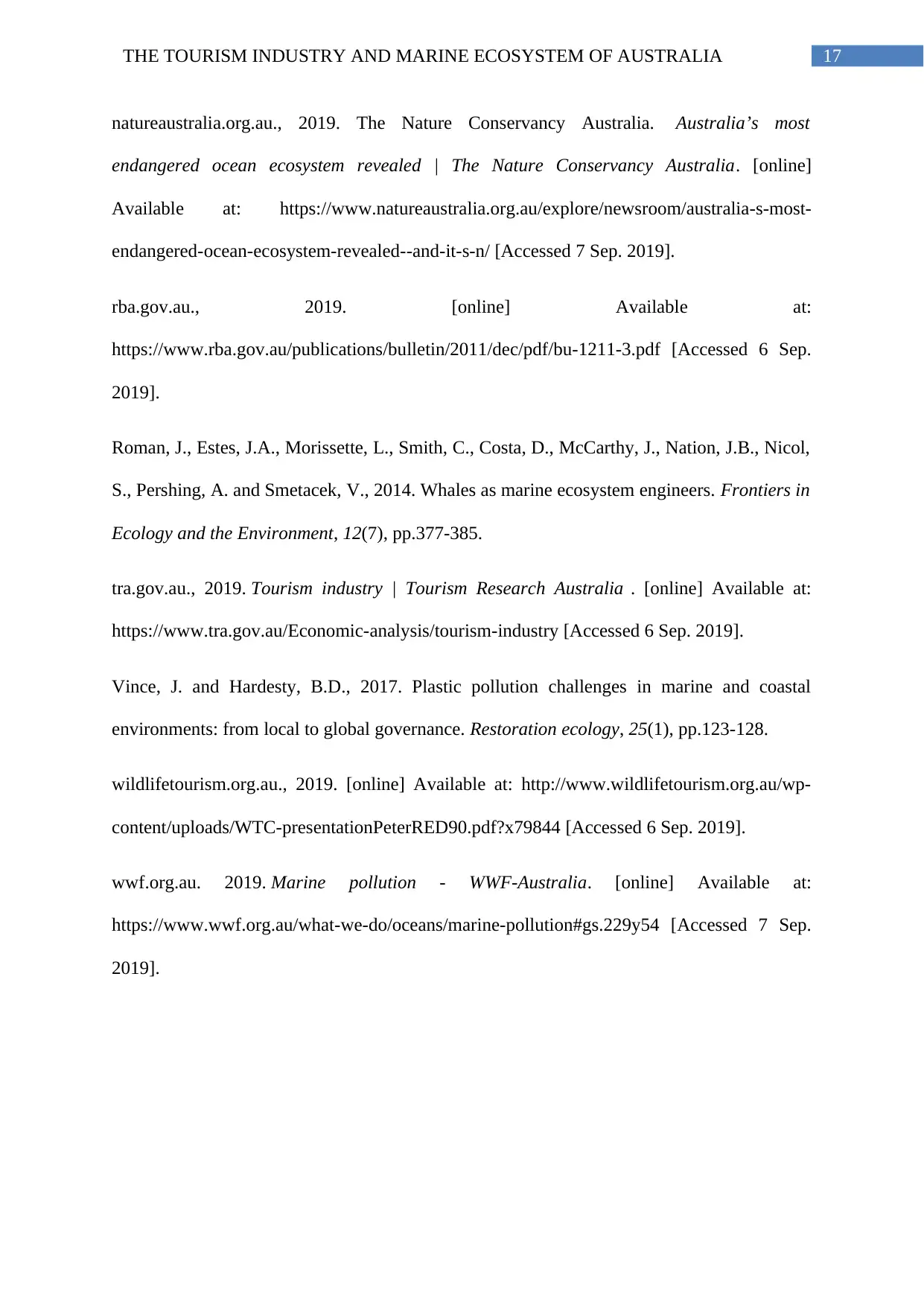
17THE TOURISM INDUSTRY AND MARINE ECOSYSTEM OF AUSTRALIA
natureaustralia.org.au., 2019. The Nature Conservancy Australia. Australia’s most
endangered ocean ecosystem revealed | The Nature Conservancy Australia. [online]
Available at: https://www.natureaustralia.org.au/explore/newsroom/australia-s-most-
endangered-ocean-ecosystem-revealed--and-it-s-n/ [Accessed 7 Sep. 2019].
rba.gov.au., 2019. [online] Available at:
https://www.rba.gov.au/publications/bulletin/2011/dec/pdf/bu-1211-3.pdf [Accessed 6 Sep.
2019].
Roman, J., Estes, J.A., Morissette, L., Smith, C., Costa, D., McCarthy, J., Nation, J.B., Nicol,
S., Pershing, A. and Smetacek, V., 2014. Whales as marine ecosystem engineers. Frontiers in
Ecology and the Environment, 12(7), pp.377-385.
tra.gov.au., 2019. Tourism industry | Tourism Research Australia . [online] Available at:
https://www.tra.gov.au/Economic-analysis/tourism-industry [Accessed 6 Sep. 2019].
Vince, J. and Hardesty, B.D., 2017. Plastic pollution challenges in marine and coastal
environments: from local to global governance. Restoration ecology, 25(1), pp.123-128.
wildlifetourism.org.au., 2019. [online] Available at: http://www.wildlifetourism.org.au/wp-
content/uploads/WTC-presentationPeterRED90.pdf?x79844 [Accessed 6 Sep. 2019].
wwf.org.au. 2019. Marine pollution - WWF-Australia. [online] Available at:
https://www.wwf.org.au/what-we-do/oceans/marine-pollution#gs.229y54 [Accessed 7 Sep.
2019].
natureaustralia.org.au., 2019. The Nature Conservancy Australia. Australia’s most
endangered ocean ecosystem revealed | The Nature Conservancy Australia. [online]
Available at: https://www.natureaustralia.org.au/explore/newsroom/australia-s-most-
endangered-ocean-ecosystem-revealed--and-it-s-n/ [Accessed 7 Sep. 2019].
rba.gov.au., 2019. [online] Available at:
https://www.rba.gov.au/publications/bulletin/2011/dec/pdf/bu-1211-3.pdf [Accessed 6 Sep.
2019].
Roman, J., Estes, J.A., Morissette, L., Smith, C., Costa, D., McCarthy, J., Nation, J.B., Nicol,
S., Pershing, A. and Smetacek, V., 2014. Whales as marine ecosystem engineers. Frontiers in
Ecology and the Environment, 12(7), pp.377-385.
tra.gov.au., 2019. Tourism industry | Tourism Research Australia . [online] Available at:
https://www.tra.gov.au/Economic-analysis/tourism-industry [Accessed 6 Sep. 2019].
Vince, J. and Hardesty, B.D., 2017. Plastic pollution challenges in marine and coastal
environments: from local to global governance. Restoration ecology, 25(1), pp.123-128.
wildlifetourism.org.au., 2019. [online] Available at: http://www.wildlifetourism.org.au/wp-
content/uploads/WTC-presentationPeterRED90.pdf?x79844 [Accessed 6 Sep. 2019].
wwf.org.au. 2019. Marine pollution - WWF-Australia. [online] Available at:
https://www.wwf.org.au/what-we-do/oceans/marine-pollution#gs.229y54 [Accessed 7 Sep.
2019].
1 out of 18
Related Documents
Your All-in-One AI-Powered Toolkit for Academic Success.
+13062052269
info@desklib.com
Available 24*7 on WhatsApp / Email
![[object Object]](/_next/static/media/star-bottom.7253800d.svg)
Unlock your academic potential
© 2024 | Zucol Services PVT LTD | All rights reserved.





